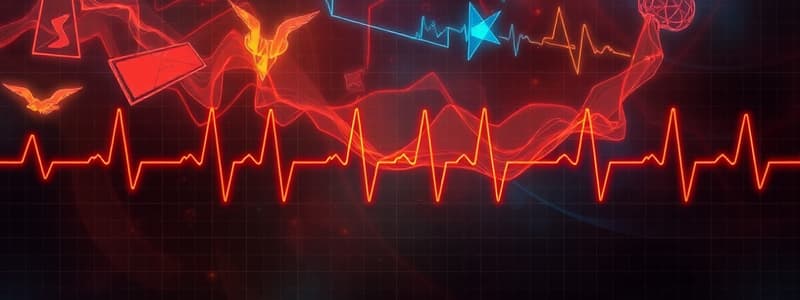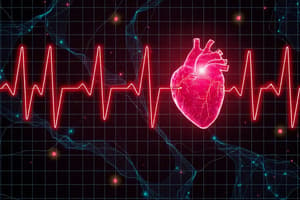Podcast
Questions and Answers
What does P wave represent?
What does P wave represent?
- Ventricular repolarization
- End of Ventricular Depolarization
- Myocardial Infarction
- Atrial depolarization (correct)
Duration and how many boxes does PR wave have?
Duration and how many boxes does PR wave have?
- 0.12-0.20 seconds =3-5 small boxes (correct)
- 0.10-0.25 seconds =10 small boxes
- 0.10-0.15 seconds =5 small boxes
- 0.20-0.30 seconds =10 small boxes
What does it mean if P wave is longer than 0.20 seconds?
What does it mean if P wave is longer than 0.20 seconds?
- Block/obstruction (correct)
- Nothing. That’s normal
- Myocardial ischemia
- Asthma
What does QRS complex represent?
What does QRS complex represent?
What does T wave represent?
What does T wave represent?
What does elevated ST segment mean?
What does elevated ST segment mean?
Elevated ST segment with increase troponin level?
Elevated ST segment with increase troponin level?
What does Right Axis deviation mean and associated with?
What does Right Axis deviation mean and associated with?
Left Axis Deviation
Left Axis Deviation
EKG pattern: SA node goes in proper conduction, PR interval (<0.20), QRS complexes are identical and no longer than 0.12 second, ST segment is flat, RR interval is regular with HR of 60-100/min.
EKG pattern: SA node goes in proper conduction, PR interval (<0.20), QRS complexes are identical and no longer than 0.12 second, ST segment is flat, RR interval is regular with HR of 60-100/min.
EKG pattern: HR exceeds 100/min at rest, each QRS complex is preceded by a P wave, common in patients with acute illness, pain and anxiety, fever, hypovolemia and hypoxemia. Can be caused by certain medications such as bronchodilators.
EKG pattern: HR exceeds 100/min at rest, each QRS complex is preceded by a P wave, common in patients with acute illness, pain and anxiety, fever, hypovolemia and hypoxemia. Can be caused by certain medications such as bronchodilators.
EKG pattern: HR less than 60/min, QRS is preceded by a P wave, PR interval and QRS complex are normal. It’s a concern when it causes hypotension and syncope. Normal for athletes and quadriplegic patients. An effective treatment would be Atropine.
EKG pattern: HR less than 60/min, QRS is preceded by a P wave, PR interval and QRS complex are normal. It’s a concern when it causes hypotension and syncope. Normal for athletes and quadriplegic patients. An effective treatment would be Atropine.
EKG pattern: PR interval exceeds 0.20 second (greater than 5 small boxes), each QRS complex is preceded by a P wave, RR intervals are regular and may occur after an MI or use of beta blockers.
EKG pattern: PR interval exceeds 0.20 second (greater than 5 small boxes), each QRS complex is preceded by a P wave, RR intervals are regular and may occur after an MI or use of beta blockers.
EKG Pattern: PR interval gets progressively longer until one does not pass on the ventricles, delay PR interval (There’s an issue of delay on the SA node to the bundle of HIS). The pattern would look like: Longer longer longer then drop.
EKG Pattern: PR interval gets progressively longer until one does not pass on the ventricles, delay PR interval (There’s an issue of delay on the SA node to the bundle of HIS). The pattern would look like: Longer longer longer then drop.
EKG pattern: Less common, Associated with problems such as MI. Its waves with no QRS.
EKG pattern: Less common, Associated with problems such as MI. Its waves with no QRS.
EKG Pattern: No communication between Atria and Ventricles (P waves and QRS complexes), PP intervals and RR are regular. Treatment includes medications to speed up the heart and a placement of pacemaker
EKG Pattern: No communication between Atria and Ventricles (P waves and QRS complexes), PP intervals and RR are regular. Treatment includes medications to speed up the heart and a placement of pacemaker
EKG pattern: Associated with rapid depolarization of atria from ectopic focus, Sawtooth pattern. Caused by Rheumatic heart disease, Coronary heart disease, stress, hypoxemia.
Treatment would be medication and cardio version (if patient has pulse)
EKG pattern: Associated with rapid depolarization of atria from ectopic focus, Sawtooth pattern. Caused by Rheumatic heart disease, Coronary heart disease, stress, hypoxemia. Treatment would be medication and cardio version (if patient has pulse)
EKG pattern: Atrial muscle quivers in an erratic pattern. Normal P waves are seen. Ventricular rate may be slow and irregular. It can cause cardiac output to drop and may lead to Thrombi or stoke. Treatment would be Cardio version.
EKG pattern: Atrial muscle quivers in an erratic pattern. Normal P waves are seen. Ventricular rate may be slow and irregular. It can cause cardiac output to drop and may lead to Thrombi or stoke. Treatment would be Cardio version.
EKG pattern: Ectopic beats originate in the ventricles, commonly caused by hypoxia, electrolyte imbalance, QRS complex are wide and bizzare, no preceding P waves. Temporary treatment would be Lidocaine
EKG pattern: Ectopic beats originate in the ventricles, commonly caused by hypoxia, electrolyte imbalance, QRS complex are wide and bizzare, no preceding P waves. Temporary treatment would be Lidocaine
EKG Pattern: 3 or more PVC runs, Easy to recognize as a series of wide QRS complex, Ventricular rate usually at 100-250/min. Treatment would be cardio version and medications. Pattern may look like Sharkfins.
EKG Pattern: 3 or more PVC runs, Easy to recognize as a series of wide QRS complex, Ventricular rate usually at 100-250/min. Treatment would be cardio version and medications. Pattern may look like Sharkfins.
EKG pattern: Quivering of ventricles, Cardiac output is 0, its most life threatening arrhythmia, cardioversion is recommended, CPR, Oxygen, Medication, pattern shows irregular fluctuations with zigzag pattern.
EKG pattern: Quivering of ventricles, Cardiac output is 0, its most life threatening arrhythmia, cardioversion is recommended, CPR, Oxygen, Medication, pattern shows irregular fluctuations with zigzag pattern.
What ECG pattern do you use Cardio version for? Select all that applies
What ECG pattern do you use Cardio version for? Select all that applies
What are the cells that are inside the myocardium? And Do they generate electrical impulses?
What are the cells that are inside the myocardium? And Do they generate electrical impulses?
What cells are responsible for spontaneous generation and conduction of electrical impulses?
What cells are responsible for spontaneous generation and conduction of electrical impulses?
What does depolarization cause?
What does depolarization cause?
What does repolarization do?
What does repolarization do?
What node is called “the pacemaker” and has the greatest degree of automaticity and controls the Heart rate?
What node is called “the pacemaker” and has the greatest degree of automaticity and controls the Heart rate?
A heartbeat generated outside of SA node is called?
A heartbeat generated outside of SA node is called?
What happens if the SA node fail? (Select all that applies)
What happens if the SA node fail? (Select all that applies)
Where does the electrical impulses from SA node travel to?
1 Av node
2 Bundle branches
3 Right ventricle
4 Left Ventricle
5 Bundle of HIS
6 Purkinje Fibers
Where does the electrical impulses from SA node travel to?
1 Av node 2 Bundle branches 3 Right ventricle 4 Left Ventricle 5 Bundle of HIS 6 Purkinje Fibers
Flashcards
Capital of France (example flashcard)
Capital of France (example flashcard)
Paris



